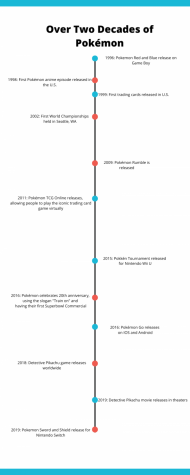The Evolution of Pokémon
December 19, 2019
In February of 1996, Pokémon released its first two games, Pokémon Red and Pokémon Blue, for the Game Boy in Japan. Almost 24 years later, Pokémon has gone worldwide with not just videogames, but also with trading cards, movies and TV shows. While the franchise is geared toward young audiences, teens and adults enjoy these games as well. With the release of two new mainstream games for the Nintendo Switch, Pokémon Sword and Pokémon Shield, Pokémon has gained new fans and brought back veterans who have played for years, and these new additions to the franchise show just how much Pokémon has evolved since its beginning.
As for the franchise’s video games, Pokémon Red and Pokémon Blue are games that have the player encountering Pokémon and either fighting or catching them. Along with battling CPUs, or computer bots, these encounters allow players to evolve and strengthen throughout the game. While this goal hasn’t changed much over the years, each new addition has better visuals than its predecessors, with Pokemon X and Pokemon Y on the Nintendo 3DS demonstrating major graphics improvements. Pokémon Sword and Pokémon Shield have found a home on the Nintendo Switch and experienced massive success, with over 2 million units sold in the U.S. within the first two days in stores, according to an article from Newsweek. Junior Garrett Jones has been playing Pokémon for years and enjoys the social part of the games.
“We trade, battle [and] just talk about it sometimes,” Jones said. “It has really helped me stay in contact with my friends at different schools.”
While the main focus of Pokémon is exploring new regions where players can catch and battle Pokémon, spin-off titles have been made that follow this concept more loosely. These games, such as the fighting game Pokkén Tournament and strategy game Pokémon Mystery Dungeon, involve the player controlling individual Pokémon and real-time combat compared to the more traditional turn-based system used in most Pokémon titles. While not into the main games, sophomore Lareen Kalle enjoys Pokémon Rumble, a game in which the player controls one Pokémon and fights multiple Pokémon until reaching a boss and defeating them in each level.
“It’s a really unique version of Pokémon,” Kalle said. “It’s not strategy based, but more attack based.”
But Pokémon is not known for only video games; it can also be enjoyed in the form of the trading card game. With the first set of cards released in Japan in October of 1996, the cards have spread all over the world and have become one of the first things kids play with when they’re introduced to Pokémon. While there is an official set of rules for the game, many people such as sophomore Sean McFadden were just interested in gathering cards.
“I really like collecting and opening packs,” McFadden said. “Everytime I go to Target, I’ll drop a couple dollars on a pack and see what I can get.”
All of the Pokémon anime and movies follow the main character Ash and his iconic Pokémon Pikachu as Ash travels across regions on an adventure to be the best trainer he can be. The first Pokemon anime episode aired in April 1997 and countless episodes have been released since. The first movie was released in November 1999, with more movies being tied close to the anime. While the games have been dominated by many age groups, the anime doesn’t have that sense of inclusion. As McFadden mentions, the excitement is not appealing to older fans of the franchise.
“While it may not have as much [excitement] for the older audience, it definitely has something for younger people,” McFadden said.
Overall, Pokémon has been a huge cultural phenomenon around the world. Whether it’s an adult competing in the World Championships, or a kid opening a card pack from Target, it has a way of connecting multiple generations together.
“You have people that have been playing since 1996, and people like my cousins who just got into it two years ago,” Jones said. “It’s able to bring people together, no matter how old you are.”


